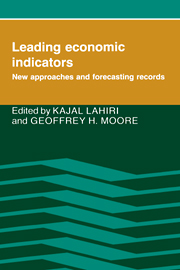Book contents
- Frontmatter
- Contents
- Preface
- List of contributors
- 1 Introduction
- PART I NEW CONCEPTS AND METHODS
- PART II FORECASTING RECORDS AND METHODS OF EVALUATION
- 9 Forecasting cyclical turning points: The record in the past three recessions
- 10 Turning point predictions, errors, and forecasting procedures
- 11 Forecasting peaks and troughs in the business cycle: On the choice and use of appropriate leading indicator series
- 12 Using a consensus of leading economic indicators to find the right ball park for real GNP forecasts
- 13 Some Australian experience with leading economic indicators
- 14 Turning point prediction with the composite leading index: An ex ante analysis
- 15 Forecasting recessions under the Gramm-Rudman-Hollings law
- 16 Leading indicators of inflation
- PART III NEW ECONOMIC INDICATORS
- Index
13 - Some Australian experience with leading economic indicators
Published online by Cambridge University Press: 05 June 2012
- Frontmatter
- Contents
- Preface
- List of contributors
- 1 Introduction
- PART I NEW CONCEPTS AND METHODS
- PART II FORECASTING RECORDS AND METHODS OF EVALUATION
- 9 Forecasting cyclical turning points: The record in the past three recessions
- 10 Turning point predictions, errors, and forecasting procedures
- 11 Forecasting peaks and troughs in the business cycle: On the choice and use of appropriate leading indicator series
- 12 Using a consensus of leading economic indicators to find the right ball park for real GNP forecasts
- 13 Some Australian experience with leading economic indicators
- 14 Turning point prediction with the composite leading index: An ex ante analysis
- 15 Forecasting recessions under the Gramm-Rudman-Hollings law
- 16 Leading indicators of inflation
- PART III NEW ECONOMIC INDICATORS
- Index
Summary
In Australia the leading and coincident indexes of economic activity, computed monthly by the Columbia University-based Center for International Business Cycle Research (CIBCR) in collaboration with Dr. Ernest Boehm of Melbourne University, have been gaining increasing prominence in economic debate. Movements in the indexes are the subject of many newspaper articles, and government and business economists alike use them to gauge the performance of the macroeconomy.
In this chapter several applications of the use of these two important economic indexes are discussed. Firstly, the degree to which movements in the leading index reliably anticipate fluctuations in the coincident index is investigated. Secondly, the usefulness of the leading index in forecasting fluctuations in telecommunications traffic is statistically evaluated. Finally, the Australian and U.S. coincident indexes are used to clarify the question of whether there is any empirical support for the view that Australia's economy is systematically led by cyclical fluctuations in the U.S. economy.
A statistical analysis of the relationship between the leading and coincident indexes
In this section the results of two related statistical analyses are presented. The relationship between the two indexes is first investigated using the technique of cross-spectral analysis; subsequently, a Granger causality analysis is conducted on the two series. [Full details of these two studies may be found in Layton (1986a, 1987a).]
The cross-spectral analysis
The choice of the technique of cross-spectral analysis is motivated by the possibility that the strength of the association between the two indexes is likely to vary according to whether swings in the leading index are short term or long term in nature.
- Type
- Chapter
- Information
- Leading Economic IndicatorsNew Approaches and Forecasting Records, pp. 211 - 230Publisher: Cambridge University PressPrint publication year: 1991
- 2
- Cited by



